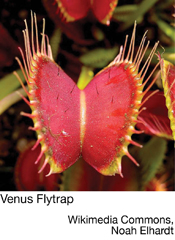

 In 1873 a
biologist detected electrical impulses in a Venus flytrap which were
the same kind of electrical waves seen in the nerve impulses in
animals. Subsequent studies have shown that there are no nerve cells in
the plants, but that waves of charged ions from sensory hairs cause
some of the plant cells to expand rapidly closing the “mouth” of the
flytrap. The system is slower than the thousandths of a second reaction
in animals, but it is very similar.
In 1873 a
biologist detected electrical impulses in a Venus flytrap which were
the same kind of electrical waves seen in the nerve impulses in
animals. Subsequent studies have shown that there are no nerve cells in
the plants, but that waves of charged ions from sensory hairs cause
some of the plant cells to expand rapidly closing the “mouth” of the
flytrap. The system is slower than the thousandths of a second reaction
in animals, but it is very similar.
Recent studies of plants have shown that when they
are eaten, a chemical reaction surges through the plant that is almost
identical to the neurohormonal reactions that regulate pain and injury
repair in animals. When leaves get nibbled, they release a hormone
resembling endorphins made by animals after an injury. In animals these
hormones help to convert a chemical called arachidonic acid into
prostaglandins which cause inflammation and pain, encouraging the
animal to get help or treat the injury. In plants, the hormone helps
convert linolenic acid into jasmonic acid, a chemical cousin of
prostaglandins. Interestingly, the reaction is so similar to animals
that aspirin or ibuprofen will stop it.
Jasmonic acid causes leaves to make enzymes called
protease inhibitors which cause indigestion in leaf eating insects. The
leaves also make cholecystokinin (CCK) which
causes insects and animals
to have a feeling of having eaten enough, which is making it a subject
of study for diet pills. Jasmonic acid is also released into the air
which causes nearby plants to turn on their defense mechanisms when
leaf eating insects are around.
The similarity of plant mechanisms to animal
mechanisms strongly suggest that they have been designed by the same
engineer, who used the same principles to develop both of them. The
complexity of the chemistry makes attributing this to chance a very
dubious choice. God has designed life to exist even when there are
dangers and predators around that could wipe it out. Having a balance
that allows this to happen is very difficult to achieve, and when man
upsets that balance the consequences can be catastrophic. As we learn
more about plants we find more amazing facts that speak of God’s wisdom
and design. Truly we can know there is a God through the things He has
made (Romans 1:20).
Source: National Wildlife,
December/January 1995,
page 18.
Back to Contents
Does God Exist?, MarApr10.



 In 1873 a
biologist detected electrical impulses in a Venus flytrap which were
the same kind of electrical waves seen in the nerve impulses in
animals. Subsequent studies have shown that there are no nerve cells in
the plants, but that waves of charged ions from sensory hairs cause
some of the plant cells to expand rapidly closing the “mouth” of the
flytrap. The system is slower than the thousandths of a second reaction
in animals, but it is very similar.
In 1873 a
biologist detected electrical impulses in a Venus flytrap which were
the same kind of electrical waves seen in the nerve impulses in
animals. Subsequent studies have shown that there are no nerve cells in
the plants, but that waves of charged ions from sensory hairs cause
some of the plant cells to expand rapidly closing the “mouth” of the
flytrap. The system is slower than the thousandths of a second reaction
in animals, but it is very similar.